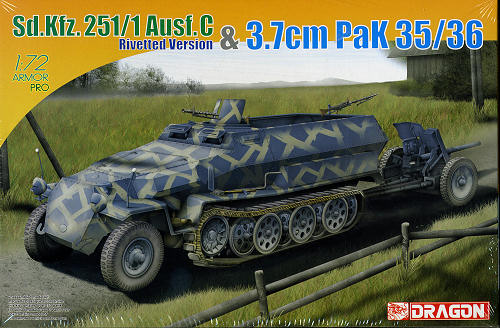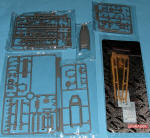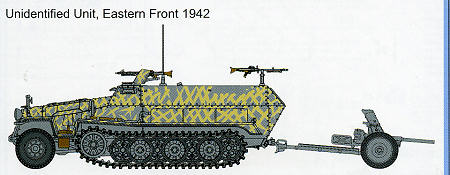
Dragon 1/72 Sd.Kfz. 251/1 ausf C with 3.7cm Pak 35/36
| KIT #: | 7371 |
| PRICE: | $ |
| DECALS: | Generic markings |
| REVIEWER: | Scott Van Aken |
| NOTES: | New mold Pak 35/36 |

| HISTORY |
The Sonderkraftfahrzeug 251 (SdKfz 251) half-track was an armored fighting vehicle designed and first built by Germany's Hanomag company during World War II. They were produced throughout the war.
The early production models of this vehicle were issued to the 1st Panzer Division in 1939. There were four main models (A - D), with many variants. The initial idea was for a vehicle that could be used to transport a squad of infantry to the battlefield protected from enemy small arms fire, and with some protection from artillery fire. The open top meant that the crew was still vulnerable, especially to high explosive rounds and shell fragments.
The first two models were produced in small numbers. The C variant had a larger production run, but was a quite complex vehicle to build, involving many angled plates that gave reasonable protection from small arms fire. The D version utilized a much simpler design, and can be easily recognized by its single piece sloping rear (with flat doors).
Although designed for cross country work, it had some limitations as the front wheels were not powered.
The standard personnel carrier version was equipped with a 7.92 mm MG34 or MG42 machine gun mounted at the front of the open compartment, above and behind the driver. A second machine gun was usually mounted at the rear on an anti-aircraft mount.
Variants were produced for specialized purposes, including with anti-aircraft guns, anti-tank rockets (triple Panzerschrecks fitted on either side of the vehicle) as well as a version with an infra-red search light used to spot potential targets for associated Panther tanks equipped with infrared detectors.
The PaK 36 (Panzerabwehrkanone 36) was a German anti-tank gun that fired a 3.7cm caliber shell. It was developed in 1936 by Rheinmetall and first appeared in combat that year during the Spanish Civil War. It formed the basis for many other nations' anti-tank guns during the first years of World War II. The KwK 36 L45 was the same gun but was used as the main armament on several tanks, most notably the early models of the Panzer III.
The PaK 36, being a small-calibre weapon, was outdated by the May 1940 Western Campaign, and crews found them all but useless against heavy allied tanks like the British Mk.II Matilda and the French Char B1 and Somua S-35. A group of these guns claimed to have knocked out a Char by firing at its flank, but this is most likely made up. The poor performance against heavy enemy armour resulted in the PaK 36 being dubbed the "Door Knocker".
The PaK 36 began to be replaced by the new 5cm PaK 38 in mid 1940. The addition of tungsten cored shells added slightly to the armour penetration of the PaK 36. When the German troops engaged the Soviet T-34 for the first time, the PaK 36 was proven totally obsolete. Despite this, it remained the standard anti-tank weapon for many units until 1942. PaK 36 crews could still achieve kills on enemy tanks but had to wait for an opportunity to hit the tank's rear armour from close range, a task requiring nerves of steel and allowing for no second attempt.
As the PaK 36's were gradually replaced, many were removed from their carriages and added to Halftracks to be used as light anti-armour support. A number of PaK 36s were also supplied to Germany's allies. The PaK 36 served with the armies of Finland, Hungary, Romania and Slovakia. In 1943, the introduction of the Stielgranate 41 shaped charge meant that the PaK 36 could now penetrate any armour, but only at a range of less than 300 meters. The PaK 36s, together with the new shaped charges, were issued to Fallschirmjäger and other light troops. The gun's light weight meant that it could be easily moved by hand, and this mobility made it ideal for their purpose.
| THE KIT |
 I've bought a few Dragon small scale armor kits in the past and have generally been pleased with them. This one is no exception and continues Dragon's concentration on providing a quality kit that rivals the large scales of just a few years ago. Dragon seems to not want to put more than two sprues in a polybag, which is just fine with me. In this case the multiple bagged items are identical sprues, as it is better to do one of an item and do two sprues full of these singular items. This particular kit includes a new mold (that's what it says on the side of the box) Pak 35/36 made with slide mold technology for increased fidelity to detail. It is a real beauty and I'd not be surprised to see this released with a gun crew in the near future.
I've bought a few Dragon small scale armor kits in the past and have generally been pleased with them. This one is no exception and continues Dragon's concentration on providing a quality kit that rivals the large scales of just a few years ago. Dragon seems to not want to put more than two sprues in a polybag, which is just fine with me. In this case the multiple bagged items are identical sprues, as it is better to do one of an item and do two sprues full of these singular items. This particular kit includes a new mold (that's what it says on the side of the box) Pak 35/36 made with slide mold technology for increased fidelity to detail. It is a real beauty and I'd not be surprised to see this released with a gun crew in the near future.
Since this is an open topped vehicle, you get a full crew compartment that includes driver's seats, instrument panel, steering wheel and other accoutrement that you'd expect from what is basically a APC. The passenger compartment has the usual racks for rifles and bags along with some jerry cans to attach to the outside of the rear doors. This is the riveted version so the exterior is festooned with little rivets where the armor is attached.
A very nice touch is that the vast majority of the road wheels are ganged together, taking away much of the chore of construction in this area, but none of the painting. Only the very outer three wheels on each side are separate. All of the attaching thingies are hidden behind them. The tracks are a specialty of Dragon that are not only easi ly glued with super glue but are of such a material that they can be painted without having to worry about the paint flaking off.
ly glued with super glue but are of such a material that they can be painted without having to worry about the paint flaking off.
Dragon provides their usual finely illustrated instructions with Gunze and Model Master paint references. Markings are provided for a vehicle of an 'unidentified unit' in 1942. Both the 251 and gun are in Panzer Grey with the 251 having an interesting cross-hatched camo scheme done in what seems to be Panzer Yellow/Tan. Two small generic sheets for insignia and license plates are provided.
| CONCLUSIONS |
Thanks to the myriad of variants and sub-variants, Dragon will be able to continue to issue kits of this important German APC for quite some time. The addition of the very nicely done Pak 35/36 makes this boxing a real treat.
| REFERENCES |
http://en.wikipedia.org November 2008 My thanks to www.dragonmodelsusa.com for providing the preview kit. Get yours today at your local hobby shop or on-line store.
Thanks to If you would like your product reviewed fairly and quickly by asite that has over 300,000 visitors a month, please contactme or see other details in the  and DLV Company for the review kit. You can find Italeri kits at your favorite hobby shop or on-line at www.testors.com
and DLV Company for the review kit. You can find Italeri kits at your favorite hobby shop or on-line at www.testors.com